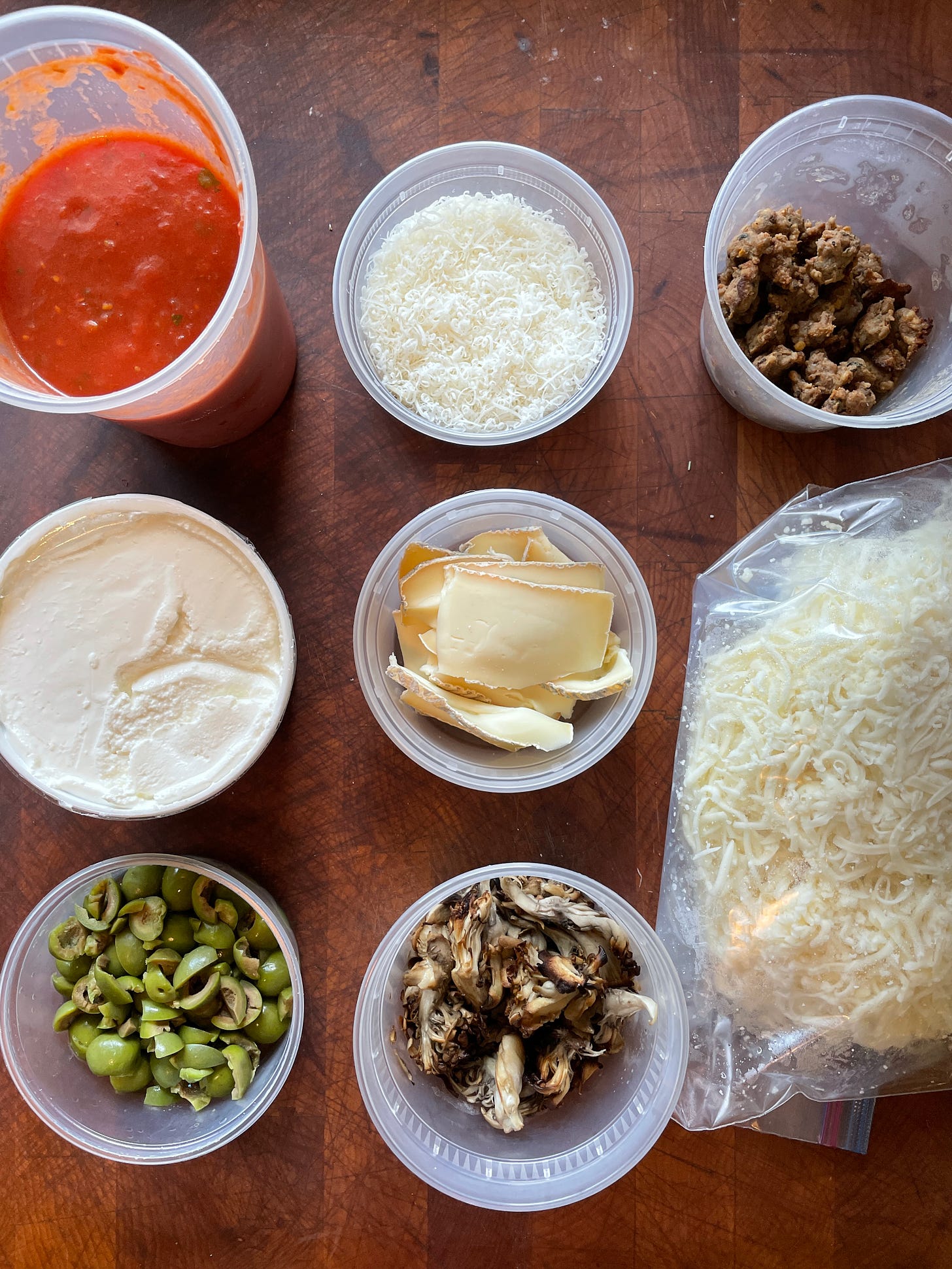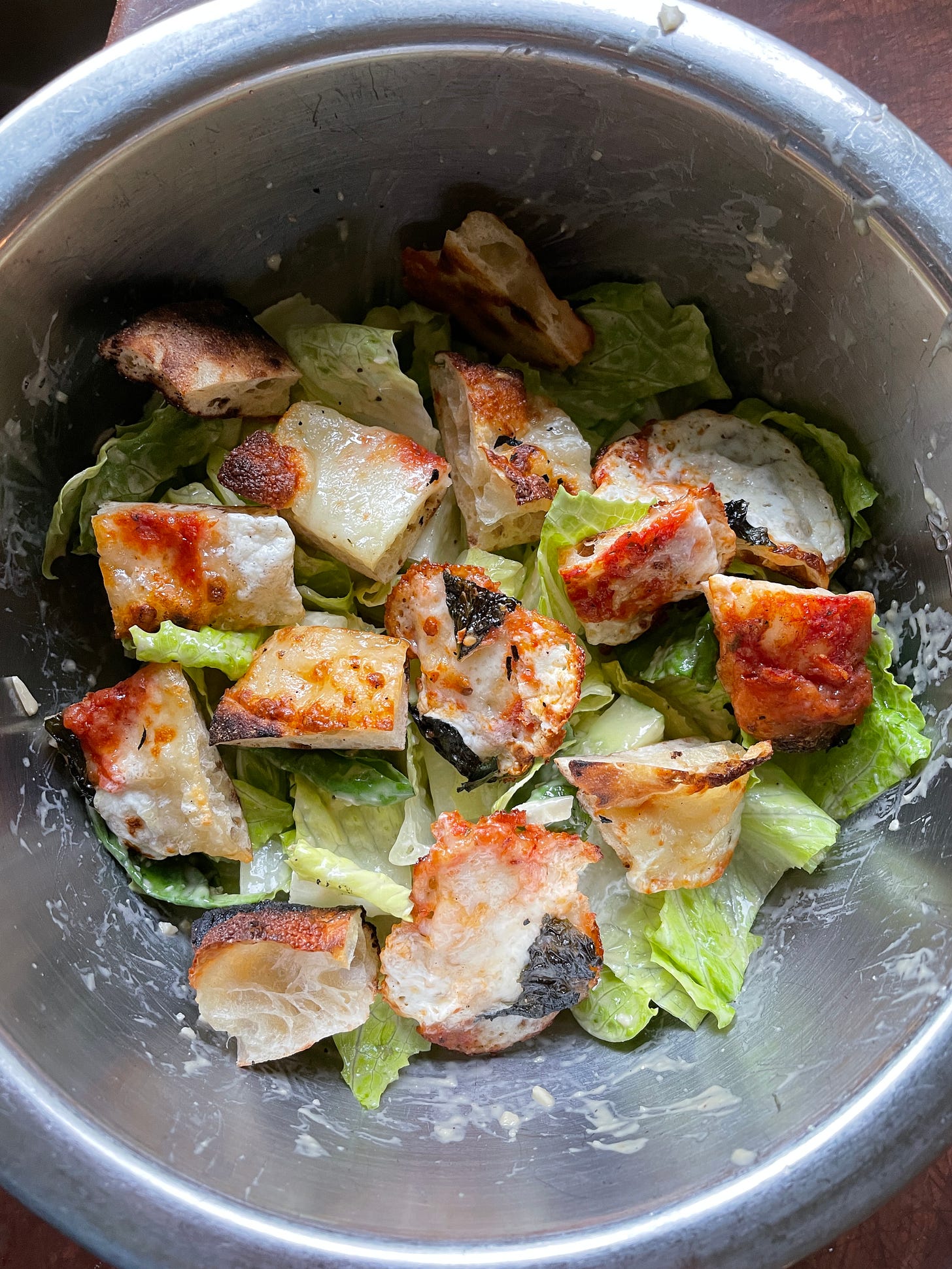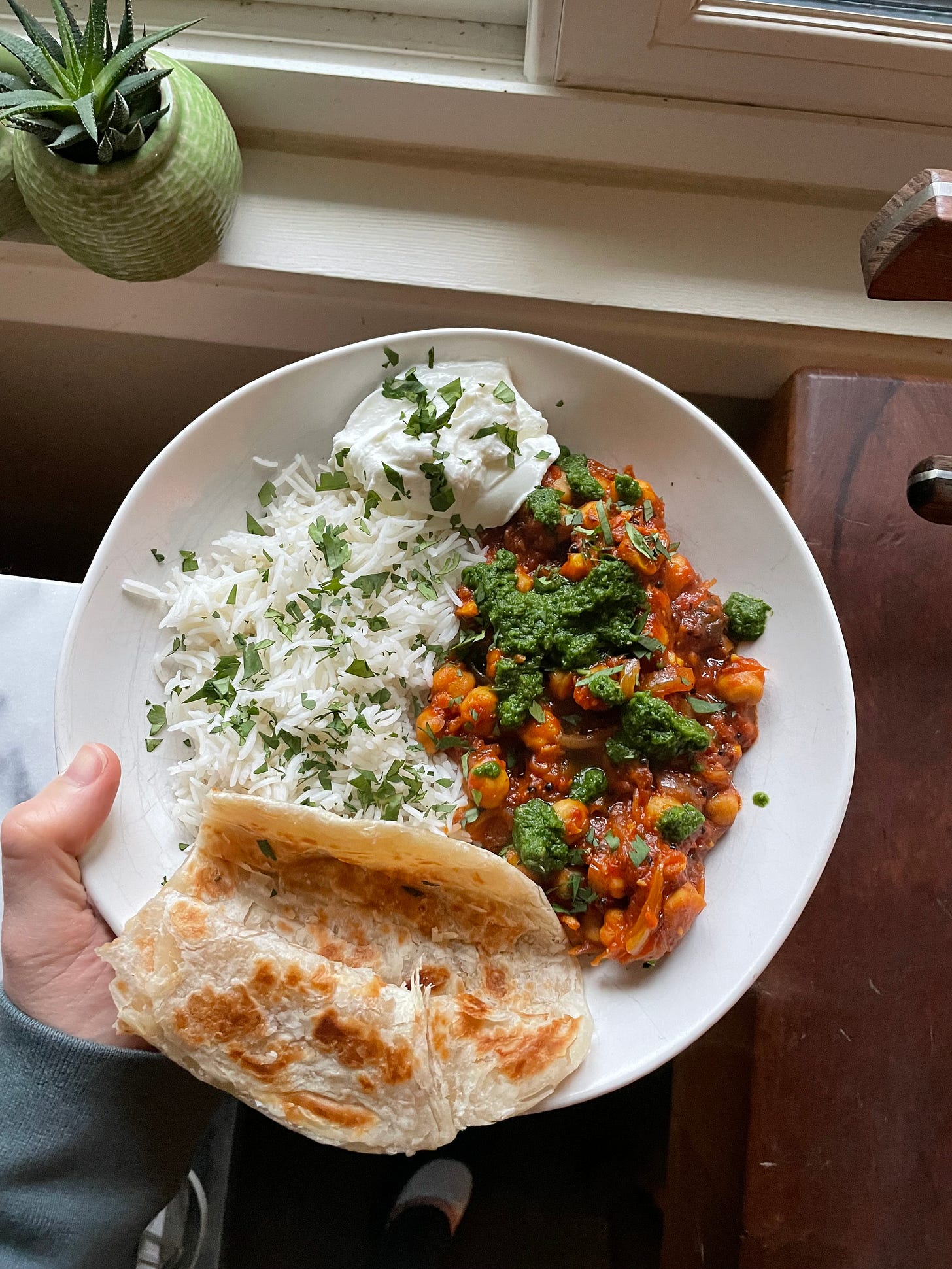We hosted our first pizza party in over two years this past weekend. We have an ooni pizza oven, which I highly recommend if throwing backyard pizza parties is something you’d like to do. You can, of course, just make one or two pizzas in it but we rarely do. We like to make a plethora of pies with different toppings, which isn’t advisable when you’re only two people. We have pizza commitment issues.
The fallout from a pizza party is leftovers of two stripes – leftover pizza and leftover pizza toppings. Leftover pizza is almost certainly a breakfast food. I have also taken to cutting leftover pizza into squares, toasting those squares in the oven, and treating them as croutons on salads, as shown. I stand by this as possibly the best idea I have ever had and I am not even a little bit ashamed of that.
Leftover pizza toppings aren’t as plug-and-play as leftover pizza, but they are similarly generative. They’re a gift of ideas in food form to your future self. Now you have building blocks, and it’s not Chopped style, where you have to glue together a few completely incompatible (and perhaps repulsive) ingredients into something judges won’t purse their lips at. It’s much kinder than that.
So this week’s meals will start out using these delicious dribs and drabs and then we will finish things out by dipping, once again, into the freezer. In the 2019 edition of Joy we wrote, “Do not treat the freezer like a science fiction stasis chamber,” and while we think that is excellent advice we also do not always practice what we preach.
Some of my friends who have ADHD tell me that one of the effects of the disorder is that object permanence is diminished. If something isn’t right in front of you, you forget it exists. I do not have ADHD but this happens to me with the freezer. I often stand in front of the open freezer muttering, “would you look at that!” In a way it’s nice, like finding a $10 bill in the pocket of a coat you haven’t worn in a while. But it can also mean throwing away bags of frostbitten vegetables or eating something from the freezer and having the sneaking suspicion that it’s had a great deal of its deliciousness siphoned off over time. This week we commit anew to not allowing that to happen.
Happy cooking!

Monday:
Stuffed shells with herbed ricotta-maitake filling and tomato sauce
We ended up not using any of the ricotta we bought for pizza making, but in a way I’m glad because now we can make stuffed shells. I usually mix gobs of herbs and lemon zest into my ricotta fillings, and I suspect tonight will be no different, but tonight I will also add roasted maitake mushrooms. If you have not roasted maitakes until their frilly edges are crispy, I advise you to try it as soon as possible. They take on a suspiciously (and deliciously) bacon-esque flavor. For the sauce I will use our leftover pizza sauce, which is uncooked. I will probably saute some garlic, add the sauce, and simmer it for a few minutes to concentrate it a bit. Of course the whole thing will be showered with mozzarella and Parm.
Tuesday:
Sausage and peppers with olive gremolata over polenta; artichokes with garlicky olive oil
Olive gremolata is something I made up just now, but it’s simply regular gremolata (parsley, lemon zest, garlic) with chopped olives added in. We’re using Castelvetrano olives, which are supremely buttery and mild. I do appreciate the old-fashioned way of making polenta but I will probably use the Instant Pot this time because we have a concert to run off to after dinner.
Wednesday:
Dinner at La Moule
We rarely go out to eat for dinner, but this is one of our favorite restaurants in Portland and we have something to celebrate. Everything at this restaurant is excellent, but we rarely stray from the eponymous moules frites, which are as close to perfect as a dish gets. This place also has, quite possibly, the best French fries in town (I’m hedging only because I haven’t tried every French fry in Portland but it seems likely). They serve them with a very nice aïoli. The combination of the juicy mussels and savory broth with the perfectly golden fries and aïoli kindles a contented feeling deep within. We make this dish at home sometimes and do a decent enough job, but this place nails it every. single. time.
Thursday:
Chicken thighs with kale and white beans; turnips in miso butter
We eat chicken thighs in some guise or another almost every week because they are reliable and tasty no matter what you do to them, and we always have some in the freezer. They are also forgiving. In fact, overcooking them is recommended. At least, we recommend it. By overcooking, I mean you’re going to want to take them well beyond the safe internal temperature threshold of 165℉ to get the best results. We aim for 180℉, at which temperature a chicken breast would be stringy and bedraggled. Meanwhile the thigh is not bothered, looking juicy and golden brown. We’ll use this recipe as a template but will skip the tarragon and capers.
John bought some salad turnips at the farmer’s market a couple weeks ago, and we’ve been sleeping on them a bit. But we had some last night in a salad and they were incredibly delicious and sweet! I happen to have some miso butter left from the weekend (just softened butter mixed with white miso) and think their natural sweetness will be phenomenal buttressed by the salty miso.
Friday:
Tamarind tempeh with baked sweet potatoes and broccoli
This tempeh recipe is a staple for us. It’s on page 288 of the 2019 edition if you have it. We steam the tempeh first, brown it in a skillet, then add a sauce of orange and lime juices and tamarind and caramelize the tempeh in the reducing sauce. If you like tempeh but have never tried steaming it before browning or otherwise flavoring it, stop reading this newsletter and try it immediately! I don’t pretend to understand why steaming it helps so much, but it improves the texture and seems to help it absorb sauces more readily. I just throw the whole block of tempeh in a steamer basket for 10 minutes, then proceed with the recipe.
I will close out this newsletter by sharing my reliable formula for baking sweet potatoes (this will not be news to many of you). Preheat oven to 400℉. Place a sheet pan lined with foil on the bottom rack and have another rack in the center of the oven. Once the oven is hot, place the sweet potatoes directly on the oven rack and bake for 45 minutes to 1 hour. The airflow around the potatoes helps them cook evenly. The sweet potatoes will exude some dark, sticky juices, which the foil-lined sheet pan will catch. When you stick a fork into the potatoes there should be almost no resistance all the way through. You can eat them right away but they hold heat almost as well as a rock so you can leave them while you make the rest of dinner. For serving, I will be seasoning them with the aforementioned miso butter.
Featured dinner from last week:
Chana masala (p. 217), basmati rice, plain yogurt, and paratha - this paratha came frozen from the Indian market (Mirch brand), but if you’d like to overachieve there is a recipe on p. 611. Buy the book to get the goods.



